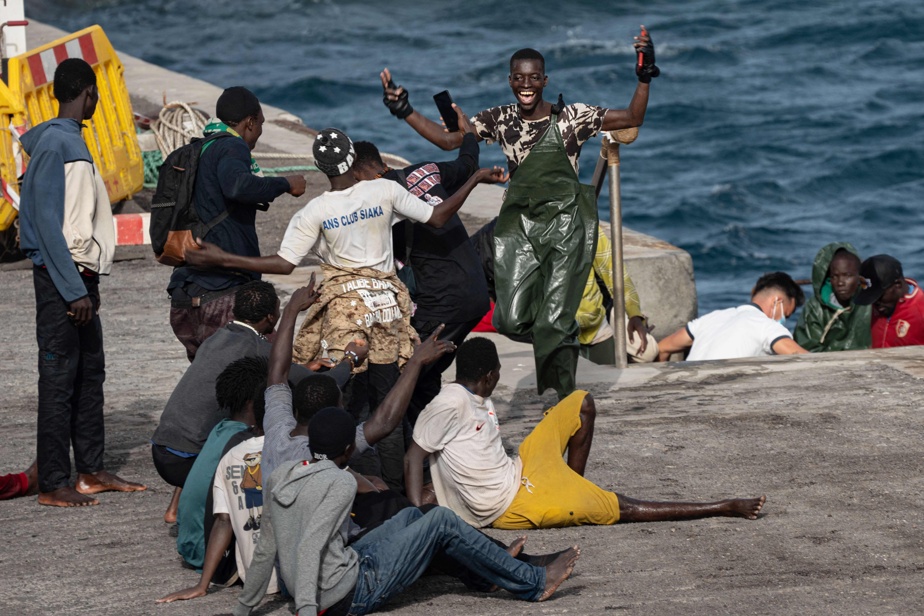(Madrid) The Spanish government of socialist Pedro Sánchez is facing a spectacular increase in the arrival of illegal migrants this fall, mainly in the Canary Islands, which feels abandoned by Madrid and Europe.
Not a day goes by without the rescue services reporting the arrival of a makeshift boat carrying dozens of African migrants in one of the Canary Islands, located off the northwest coast of the African continent.
So much so that Mr. Sánchez has decided to make a tour from Tuesday to Thursday of three West African countries that play a central role in this area: Mauritania, Gambia and Senegal.
Mauritania has become the main departure point for migrants in recent months. According to a source from the Spanish government presidency, the country is currently hosting some 200,000 refugees who are victims of the instability in the Sahel, including many Malians, who are potential candidates for departure to the Canary Islands.
The total value of the agreements that will be signed with these countries – including Mauritania, where Mr. Sánchez had already visited in February – to help them and encourage them to redouble their efforts to prevent these departures is not known.
The president of the regional government of the Canary Islands, Fernando Clavijo, urged the EU on Friday to take responsibility, “so that the Canary Islands do not have to bear all the migratory pressure from Europe alone”, because these migrants “arrive in Europe, in Spain, and not just in the Canary Islands”.
In fact, the Canaries, and more generally Spain, are often only a stopover on the road to other European countries, first and foremost France.
Minor migrants
Between 1er Between January and August 15 of this year, 22,304 migrants arrived in the Canary Islands, compared to 9,864 in the same period last year, an increase of 126%. For Spain as a whole, the increase is 66% (from 18,745 to 31,155).

PHOTO ANTONIO SEMPERE, AGENCE FRANCE-PRESSE
The crew of the Spanish Maritime Search and Rescue Agency ship Salvamar Adhara attached a tow cable to a boat after rescuing the 63 migrants who were drifting off the coast of the port of La Restinga, where they were eventually brought ashore on the Canary island of El Hierro on August 21.
Moreover, this upward trend is expected to intensify by the end of the year, due to the expected improvement in navigation conditions in this area of the Atlantic.
The record figure of 39,910 arrivals recorded last year will therefore probably be shattered, confirming that this Atlantic route to the Canaries has become the main access route for migrants to Spain, despite its extreme danger, which causes the death of thousands of them each year. The first migrants arrived in the archipelago in August 1994.
But the Canaries are not the only region in southern Spain affected by this phenomenon. The small city of Ceuta, a Spanish enclave on the northern coast of Morocco, has also recorded a sharp increase in arrivals in recent weeks.
Ceuta is one of only two EU land borders with the African continent – the other being at Melilla, another Spanish enclave further east.
For these regions, the most pressing problem is that of child migrants arriving alone, known in Spain as Mena (unaccompanied foreign minors), their situation having major domestic policy implications.

PHOTO ANTONIO SEMPERE, AGENCE FRANCE-PRESSE
A member of the emergency services carries a child, part of a group of 175 migrants who arrived on a boat, at the port of Restinga on the Canary Island of El Hierro, on August 18.
Abandoned
While adult migrants fall under the financial responsibility of the central state, those under 18, on the other hand, are the exclusive responsibility of the regions.
The Spanish regions located on the front line are therefore completely overwhelmed by the explosion in the number of child migrants they have to take care of.
In the Canary Islands, the regional government currently has to provide for 5,100 foreign minors, while the capacity of its reception centres is only 2,000 people. The situation is similar in Ceuta.
The Canary Islands archipelago is “on the verge of collapse,” Clavijo said in an interview published Monday by the daily The Worldfearing “a catastrophe” this autumn and even considering that the number of arrivals could reach 50,000 this year.
To solve this problem, the government of Pedro Sánchez tried to get Parliament to vote in July on a modification of the immigration law, in order to give the central government the right to distribute foreign minors among all the regions of the country.
But the Popular Party (right), Vox (extreme right) and the Catalan independence party of Carles Puigdemont, who advocate a tougher policy against illegal immigration, have prevented any discussion of the text.
For the time being, the government of the Canaries is left to its own devices and feels abandoned in the face of a phenomenon that is beyond its control and which will continue to get worse.
“We cannot put walls on the ocean,” Mr. Clavijo sums up fatalistically in the interview with The World.
